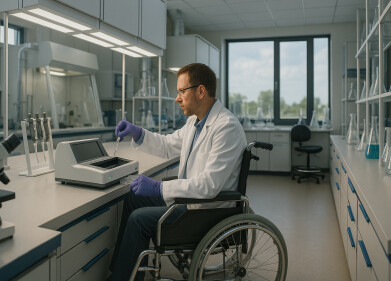-
.jpg) University of Glasgow main building Credit: University of Glasgow
University of Glasgow main building Credit: University of Glasgow
News
Smart Design – can Medical Implants be Self-Sensing?
Jun 17 2021
“3D printing gives us a remarkable amount of control over the design and density of the cellular structure” – Shanmugam Kumar
Using 3D print technology a team of engineers led by the University of Glasgow invented forms of lightweight, impact-resistant plastic-based ‘honeycomb’ structures with the ability to sense areas of damage through changes in electro-conductivity. This approach, which used the plastic-based material polyether ether ketone (PEEK), offers potential for use in ‘smart’ prosthetics and medical implants, the researchers suggested.
Nanofibres carry structural charge
The addition of microscale carbon fibres during the print building process enabled the material to carry an electric charge throughout its structure. Stress testing was applied to three designs – a hexagonal structure, a cross-shaped chiral structure and a six-sided re-entrant design using the carbon-fibre PEEK material and conventional PEEK- to determine whether damage would affect the composite’s electrical resistance. If so, it could give the new material the ability to ‘self-sense’ – allowing a hip implant, for example, to report when its conductivity has changed, indicating that it has worn down and needs to be replaced.
In crush tests, where consistent pressure is applied until the structure collapses, each design of the carbon-fibre PEEK was outperformed by its conventional PEEK counterpart, which were able to withstand higher pressures.
However, in impact tests, where a weight is dropped from height onto the structures, the three carbon-fibre PEEK structures demonstrated greater resistance to damage. The hexagonal honeycomb configuration of the carbon-fibre PEEK had the best response, withstanding greater impacts than any of the others.
In the crushing tests, the researchers also measured the carbon-fibre PEEK cellular structure’s resistance to an electric charge as the three different structures were strained. The change in resistance to applied strain - a measure of damage progression known as the piezoresistive sensitivity - decreased as the compressive strain increased, leading to a near complete loss of electrical resistance when the structures were completely crushed. The different gauge factors observed for different configurations is associated with their rate of damage growth in accordance with their ability to absorb energy, suggesting that the piezoresitivity of carbon-fibre PEEK could be of benefit in creating a new generation of smart lightweight multifunctional structures.
PEEK invaluable to industry sectors
Dr Shanmugam Kumar, of the University of Glasgow’s James Watt School of Engineering, is the corresponding author of the paper. Colleagues from Khalifa University in the United Arab Emirates and the University of Cambridge in the UK also contributed to the research. Dr Kumar said: “The unique properties of PEEK have made it invaluable to many industrial sectors, and we hope that the carbon-fibre engineered PEEK cellular structures that we’ve been able to build via 3D printing will open up further possibilities.
“3D printing gives us a remarkable amount of control over the design and density of the cellular structure. That could allow us to build materials which more closely resemble the physiology of the native bone than the solid metal alloys traditionally used in medical implants like hip or knee replacements, potentially making them more comfortable and effective.
“We hope that these cellular forms of microengineered lightweight, self-sensing PEEK we’ve developed will find new applications in a wide range of fields, not just in prosthetics and other medical devices but also in automobile design, aerospace engineering, and the oil and gas sector.”
The research was supported by funding from the University of Glasgow and Khalifa University
The team’s paper, titled ‘Energy absorption and self-sensing performance of 3D printed CF/PEEK cellular composites’, published in Materials & Design is available online
Further information online
Digital Edition
Lab Asia Dec 2025
December 2025
Chromatography Articles- Cutting-edge sample preparation tools help laboratories to stay ahead of the curveMass Spectrometry & Spectroscopy Articles- Unlocking the complexity of metabolomics: Pushi...
View all digital editions
Events
Jan 21 2026 Tokyo, Japan
Jan 28 2026 Tokyo, Japan
Jan 29 2026 New Delhi, India
Feb 07 2026 Boston, MA, USA
Asia Pharma Expo/Asia Lab Expo
Feb 12 2026 Dhaka, Bangladesh


















